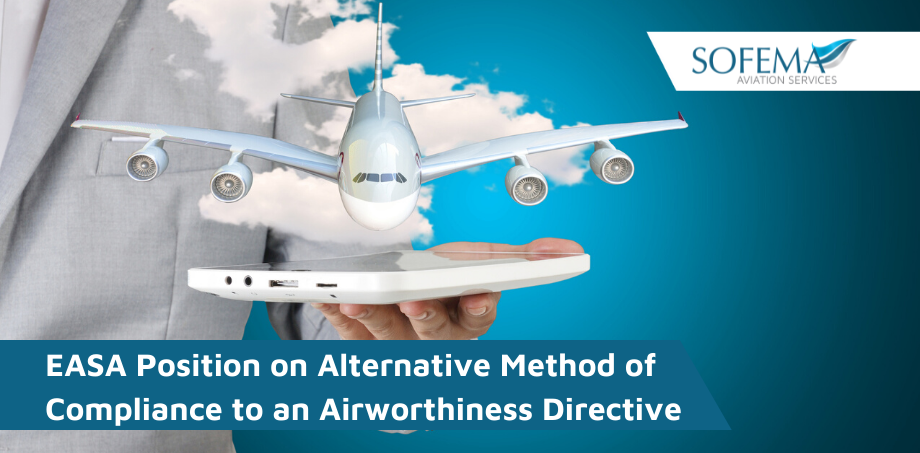A review carried out by Sofema Aviation Services (SAS) www.sassofia.com
Introduction
With approval from EASA, it is possible to develop an Alternative Method of Compliance with an Airworthiness Requirement. (Each AMOC application should relate to one AD only.)
An Alternative Method of Compliance (AMOC) is an EASA approved deviation to an AD. It is a different way, other than the one specified in an AD, to address an unsafe condition on products, parts, and appliances.
EASA can accept AMOC applications for any AD that has been issued or adopted by EASA.
EASA does not publish AMOCs to its website, or add the AMOCs to the AD tool – EASA provides the AMOC approval only to the applicant (the AMOC approval holder) that has applied for it and, if relevant, to the authority of the state of registry (in case of an application coming directly from an operator).
An AMOC must provide a level of safety equivalent to the level of safety to be restored by compliance with the original AD. AMOCs may be issued in respect of, but are not necessarily limited to, the following:
- Alternative modifications,
- Alternative inspection procedures,
- Alternative maintenance intervals and/or procedures,
- Specific operating procedures or limitations, etc.
Notes
- If the AMOC application is linked to a Minor or Major Design Change or STC application it is necessary to first ensure approval of the related Minor or Major Design Change or STC approval.
- Regarding FAA AMOC approval:
o Ref TIP 4.4 (With TIP Rev.6) View.
- When will EASA issue the AMOC approval?
o Following technical investigation & approval of AMOC EASA will immediately issue the approval, in electronic format and by email, to the applicant.
- An AMOC may not be submitted until the AD is issued (not acceptable for “Proposed AD”).
- A superseded AD will always invalidate any AMOC related to that AD.
o The AMOC approval holder must re-apply for an AMOC to EASA, using FO.CAP.00042.
- A revision of an AD cannot introduce more stringent requirements, therefore AMOC requirements remain valid following a re-issue.
Note – Requests for extension of compliance time without other alternative compliance methods or compensative factors are in general not eligible for an AMOC application.
- The operator may apply to the NAA for a temporary exemption (Article 71 (BR)).
o A justification document from the TCH may be suitable to support such a time-limited exemption on a case-by-case basis.
- Regarding AMOC If the State of Design (S of D) is the USA, Canada, or Brazil, then EASA has three separate ED Decisions where an AMOC approval held by the TC/STC holder of the product to which the AD applies is confirmed as automatically considered approved by EASA.
o For all other State of Design countries an AMOC application must be submitted to EASA using FO.CAP.00042. (Prior issuance of an equivalent AMOC recommended by S of D) see also BR Article 129.
- Transport Canada (TCCA) AMOCs are approved IAW Article 4 of EASA Decision 2004/02/CF.
- Approval for Brazil ‘Departamento de Aviação Civil,’ Centro Tecnico Aeroespacial (DAC/CTA) for products designed in Brazil. Is reference I.A.W. article 4 of EASA Decision 2004/03/CF.
EASA cannot accept applications for AMOCs referring to aircraft that are not registered in an EASA Member State, as this is outside of EASA’s jurisdiction. In these situations EASA advises operators to either:
- Contact their local National Aviation Authority (NAA) for a national AMOC or similar approval.
- The European TC holder of the product to which the AD applies may provide technical assistance for the NAA’s decision.
If the AMOC is of general applicability the European TC holder should apply for an EASA AMOC.
What`s more :
Next Steps
Follow this link to our Library to find & Download related documents for Free.
Sofema Aviation Services & Sofema Online provide classroom, webinar & online training. For additional information please email team@sassofia.com
Tags:
aviation, EASA, FAA, SAS blogs, AMOC, Aircraft Design Changes, Airworthiness Directive (AD), Alternative Method of Compliance, FO.CAP.00042, National Aviation Authority, EASA Decision 2004/02/CF





